Quantum technology is a highly disruptive field in today's world, providing unprecedented capabilities that were once deemed impossible. These transformative technologies are not decades away; many are already accessible, and we anticipate even more advancements in the coming years. While we may not have fully tapped into the complete potential of quantum, we are making significant progress towards harnessing its power. Therefore, it is crucial to explore how quantum technology can contribute to your goals. The earlier you embark on this exploration, the sooner you can leverage its benefits and gain a competitive edge.
You must be wondering why exactly are quantum technologies getting so much attention nowadays? Why are more and more companies investing in the quantum world?
To answer these questions, let me start with an example of quantum computing. You may have heard about Moore’s law, which is an empirical law that states that the number of transistors in a chipset doubles about every two years. And, if we stick to its original definition, growth continued steadily past 2020. However, we have reached a point where transistor size is not significantly changing from one generation to the next, validating the "end of Moore’s law" claim.
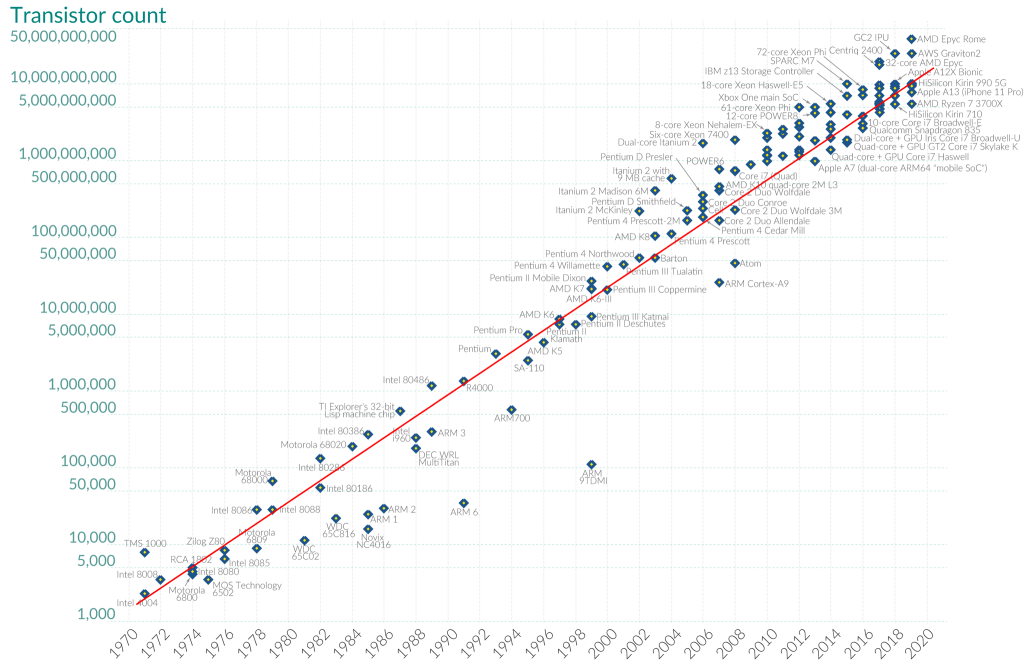
Quantum technologies have the potential to offer a way to continue improving scaling and computational power beyond the limits of classical computing, which are anticipated as Moore's Law approaches its end. Particularly, quantum computing provides an alternative approach to computation. Quantum computers use quantum bits to perform calculations. Using superposition and entanglement, properties exclusive to quantum systems, they can solve certain problems more efficiently than a classical computer can. Here, we are taking a different approach to improving computation power. Quantum computers can use quantum algorithms to perform computations across a vast number of possible states. These algorithms offer exponentially faster processing with respect to classical computers.
But how much is this exponential improvement with respect to classical computers? Here’s one problem. Suppose we give you the number 21 and ask you to find its prime factors. You may see easily that 21 is 3 times 7. But what if I now give you a 617-digit number and ask you to do the same? Now it’s not that easy. What we want to discuss here is how hard the problem becomes as the number of digits increases. For the hard case, a classical computer able to perform one billion operations per second, at a clock rate of GHz, would take about 10 to 14 years to find the prime factors. However, recent estimations suggest that a quantum computer made of 4096 perfectly stable qubits operating at a MHz clock rate, or 1 million operations per second, could solve this problem in about 10 seconds using Shor’s algorithm. This difference, from 10^(14) years to 10 seconds, is called exponential speedup.
We can find two kinds of speedup when solving complex tasks that quantum offers us with respect to classical. The first one is called exponential speedup. This figure represents the difference. The blue curve corresponds to problems for which the number of operations required to find a solution with a classical computer scales exponentially with the problem size. Like the one we have mentioned, where the computation power explodes as we increase the size of the problem. For some of those problems, we know quantum algorithms that grow as X to the power of some integer N, where X is the problem size. Such functions grow much slower than the exponential function. For that reason, it would be particularly interesting to tackle problems like integer factorization on a quantum computer.
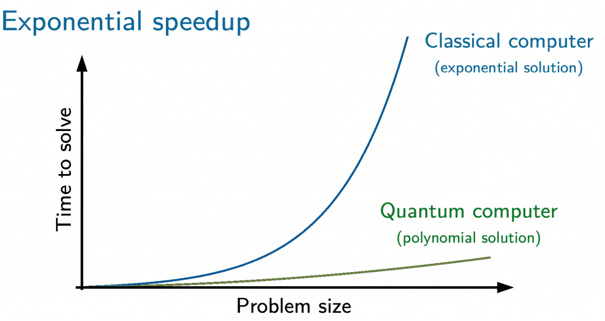
There is another case in which quantum offers us an improvement, and that is when the problem has a polynomial scaling. One example is when you want to find a specific element in unsorted data. A conventional approach is to check element by element until you find the one you were looking for. In the best-case scenario, you will find the right element on the first try, and in the worst case, after N queries for a database of size N. So the complexity of the problem is directly proportional to its size. We say it scales as N, or it's linear scaling. On a quantum computer, Grover's search algorithm allows you to find the solution in the square root of N queries. If N is small enough, the difference can be neglected. But if N is large, this is not something we want to omit.
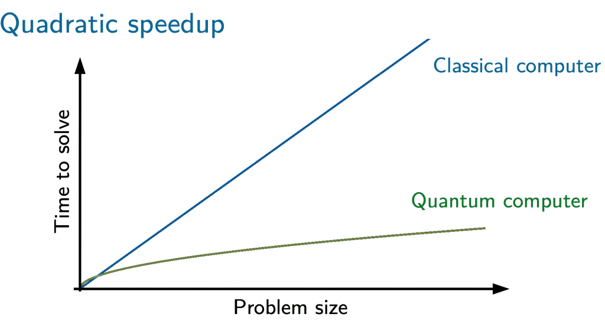
While quantum computing is still in its early stages of development and faces significant technical challenges, it holds great promise for tackling problems that are currently intractable for classical computers. As researchers continue to improve qubit stability, error correction techniques, and scalability, quantum computing is expected to surpass the computational power of classical computers.
Quantum computing is evolving from the era of Noisy Intermediate-Scale Quantum (NISQ) devices towards the goal of achieving Fault-Tolerant Quantum Computing (FTQC). NISQ computers, pioneered early quantum experiments and demonstrated the potential of quantum algorithms. As hardware and software advancements continue, the field is progressing towards building FTQC systems capable of error correction and scalable operations.

Even though there are already some quantum computers on the market that are able to solve some tasks, there is still a long way to go. To be able to estimate how fast quantum computers are going to grow, there are a lot of different variables that we have to take into account. It is not just the number of qubits that our computer has, but also
- how precise we know the state of the qubits (Fidelity),
- how much we can rely on the operations done on the qubits (Gate error rate)
- how to connect multi-qubits on chips,
- how to control qubits at scale
- How to determine cost effective power requirements
- or how to automate the production.
Yes, it's a lot ! For that reason, fault tolerant quantum computation is a long-term goal. We may not be able to solve some complex problems using FTQC right now, but using a hybrid quantum-classical system, meaning accessing the NISQ computers via a cloud access could be useful for some domain specific applications in the next few years.
It is important to highlight that quantum computers have the potential to break public-key encryption, which poses a significant threat to areas such as national security, financial systems, healthcare, and personal information privacy.
But how is digital security altered by quantum technologies? We have mentioned the factoring problem before. That problem was important because it is the basis of RSA encryption, a widely used asymmetric encryption algorithm and one of the most popular and well-established cryptographic systems. This encryption relies on the fact that it is computationally infeasible to factorize large numbers efficiently. We have seen how it would take about the age of the universe to solve the problem for a classic computer if we used enough digits. However, we mentioned how, using a quantum algorithm, we can demolish the computation and solve it in a matter of seconds. Therefore, all of the RSA's security may be compromised by algorithms like Shor's algorithm. Symmetric cryptography is a little more prepared for the threat of quantum computing. Grover's search algorithm, which provides at most a quadratic speedup in comparison with classical search algorithms. Hence, it is necessary to learn how to evaluate the possible impact of quantum computing on the effectiveness of today’s encryption systems and update them if necessary.
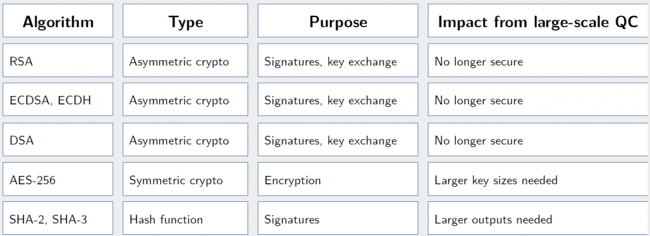
To protect against such threads, one option is to develop quantum-resistant algorithms. For instance, the security of lattice-based algorithms. This problem is related to the difficulty of finding a point that satisfies some conditions within a lattice composed of hundreds of spatial dimensions. This could be to find the point in the lattice that is as close as possible to the origin point on the lattice, down to a given precision. For a large number of dimensions, the problem has no known efficient solution, even with a quantum computer. Most lattice-based key exchange algorithms are quite simple, efficient and highly parallelizable, which makes them a piece of choice for next-generation cryptosystems.
On the other hand, quantum cryptography provides a set of techniques to reach physical security. This would allow us to communicate eliminating the possibility of the message being decrypted by an eavesdropper, even for future algorithms. In quantum cryptography we exploit quantum mechanical properties to perform cryptographic tasks, the best known example of which is quantum key distribution (QKD) which offers an information-theory secure solution to the key exchange problem. We take advantage of the no cloning theorem, which states that it is impossible to make a perfect copy of an unknown quantum state without modifying it, to exchange a key that we will use to code the message using the one-time pad classical encryption method. Combining one-time pad encoding and QKD we should be able to communicate completely safely. Therefore, having quantum computers may enable us to exchange information with the security of not being listened to by third parties with access to other quantum computers.
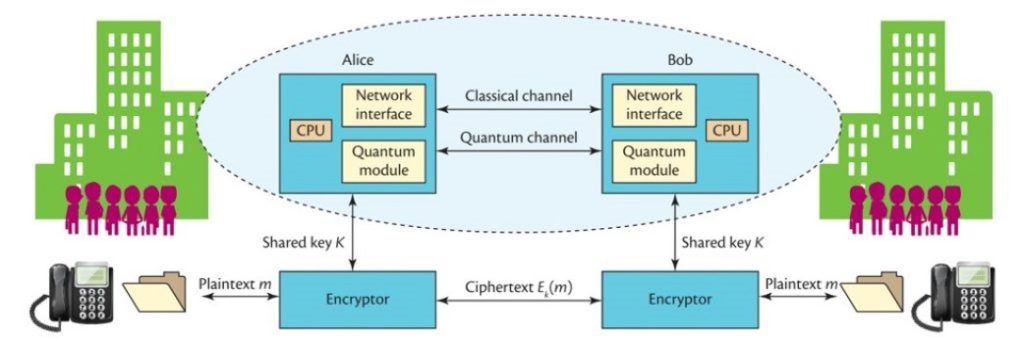
To sum up, Quantum technologies represent the future of computing, going beyond the limitations of Moore's Law. Quantum algorithms offer unprecedented speed, enabling complex calculations and breakthroughs in various fields. They have the potential to overcome the current limits of classical computing, opening doors to solve problems that were once considered intractable. However, the emergence of quantum also raises security concerns due to its ability to dismantle public-key encryption. Research on the security and scalability of QKD is progressing, and the development of QKD is still maturing. QKD is not a replacement for current applications of cryptography, but it could be a way of securely communicating in the future.
Move on to the next topic where you will discover how to capitalize on the emerging opportunities in quantum and build your strategies accordingly. See you there!



